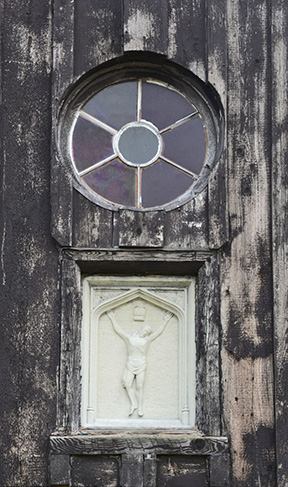Mystery surrounds Etienne Pensoneau's third wife and the course of their daughter Rebecca's life
Etienne Pensoneau was married—and widowed—three times. Two children from his first marriage, Laurent and Susanne, married and raised families in the area. When these siblings were well into their twenties, Etienne and his third wife, Elizabeth Clark, had a daughter, Marie Rebecca, born March 17, 1817.
She was christened several months later, on November 2 at Holy Family Church, along with her niece Isabelle, who was just a bit younger. As part of the ceremony, Etienne named his children Susanne and Laurent as Rebecca’s godparents. No relatives of his wife are mentioned in the records, and in fact, nothing is known at all about Elizabeth Clark’s family or background, apart from her own earlier marriage.
Elizabeth died when Rebecca was very young, followed shortly by Etienne. Upon his death on New Year’s Eve of 1820, Rebecca became an orphan at less than four years of age. It’s not known where she lived, though Laurent probably raised her along with his children in the Pensoneau-Caillot Pioneer House, up on the bluff in Little French Village. A contemporary account notes that his household was bustling, and that he and his wife took in other children as part of their family. Another researcher has noted that the inventory of Laurent’s possessions after his death includes clothing for a young girl of Rebecca’s age.
If this is the case, his death in December 1832 would have presented a turning point in Rebecca’s life. She was fifteen years old, and Laurent’s widow remarried within months. Six years later, Rebecca re-emerges onto historical records in Texas, when she marries William H. Magill in Bastrop, on March 27, 1838. How she got there, no one knows.
A possible link, though, lies with the family of her mother’s first husband, John Kerr, or Jean Carr, as he is listed in the French record of their marriage by a Justice of the Peace in St. Clair County in 1810. Elizabeth gave birth to a son, named John Kerr, six months after her husband’s death in May 1812. When she married Etienne Pensoneau two years later, the boy would have been an older brother to Rebecca in their family household.
The Kerrs were a large clan who first came to Missouri in 1799, along with Christopher Clark and Alexander Clark; the latter married Mary Kerr, the oldest of the children. Most of the Kerrs returned to Kentucky, however, only moving permanently to the St. Louis and Cahokia areas about ten years later. The father was a Baptist preacher, and several brothers would hold public offices in Missouri.
John’s brother James Kerr was a state legislator in Missouri before he and his family moved to Mexico in 1825 as one of the original settlers in Stephen Austin’s colony at San Felipe, Texas. James Kerr also served as the lawyer, administrator, and surveyor for Green DeWitt’s colony in Texas, centered on the town of Gonzales. Many people from Missouri were drawn to these colonies, for both Stephen Austin and Green DeWitt came from that area and worked hard to recruit the hundreds of settlers they needed for the colonies to succeed.
Rebecca’s connection to the Kerr family could explain how she got to Texas, and even how she met her husband, for the Kerrs had owned a farm adjacent to the Magills’ land back in Kentucky. Some close tie to the Kerrs did exist, for Rebecca and William named their first son after James Kerr.
Rebecca’s decision to go to Texas indicates some sense of adventure. Texans had fought a war for independence from Mexico in 1836, the new Republic was struggling, and the town of Bastrop, where she and William settled, was on the northern frontier and beset by Comanche Indian raids. On top of that, she was marrying a Protestant, which, according to family history, prompted her relatives back in Illinois to disown her for marrying outside the Catholic Church.
So, it must have been love, plus a spirit of adventure, and the confidence to start new lives in a new place. She would have learned those qualities from her father, who immigrated to Illinois, and possibly from her mother, as well as from stories about their ancestors. Her husband, William Magill, was quite an adventurer on his own, and several of their children would continue pioneering by leaving Texas in the 1880s for the new territory of Washington state.

